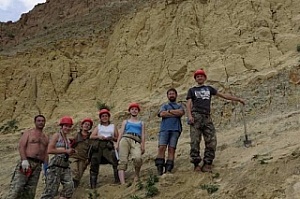During their expedition in the Achinsk District of the Krasnoyarsk Krai, a group of researchers led by Sergey Leshchinskiy, head of TSU's Laboratory of Mesozoic and Cenozoic Continental Ecosystems, discovered a previously unknown location of dinosaur and mammoth fauna. The remains of dinosaurs were found in the Big Ilek open-pit mine, and above them, there is a horizon with bones of mammoths.
The main task of the trip was not to search for fossil organisms, but to make detailed stratigraphic description of the entire stratum of the open-pit mine. But in the process of geological research, scientists found the remains of large herbivorous (presumably sauropods and stegosaurs) and carnivorous dinosaurs. In the mammoth level, they found bones of mammoths, rhinoceroses, and predators.
- The remains of the mammoth fauna are mainly fragments, although their locations are subaerial - that is, they are buried not in water, but on the earth's surface. As a rule, bones in such cases are found weathered, but relatively intact, and here practically all of them are broken, - says Sergey Leshchinskiy. - We did not find bite marks of predators on them, therefore, probably, ancient humans were connected with it.
The head of the expedition notes that it was very difficult to investigate what was uncovered. The open-pit mine, from 40 to 60 meters high, is overgrown with vegetation in some areas, and on the other side are sheer falling walls. As a result, the expedition members had to dig a lot and simultaneously use climbing equipment.
- Until now, in this very large section in the Mesozoic part, the paleontological part was unknown, that is, in the ancient sediments there was only rare pollen of extinct plants, continues the scientist. - Although locals sometimes found scraps of large bones and teeth in screes, they belong to mammoths and come from relatively young Pleistocene sediments, probably not older than 30,000 years. Now the Mesozoic part of the open-pit mine has a paleontological justification for its early Cretaceous age (probably 120-100 million years ago), which is very important for paleontology and stratigraphy. Studying these remains, we can specify the age of the deposits.
In its structure, the new location resembles the Shestakovsky Yar in the Kemerovo Region, where one of the largest clusters of dinosaur and mammoth fauna in Russia is located. Sergei Leshchinskiy says that these two open-pit mines are very similar in geology, and the only thing that has not yet been found in the Big Ilek is the Paleolithic artifacts (the ancient stone age of mankind). The TSU scientists plan to continue research on the unique open-pit mines in the Krasnoyarsk Krai.

